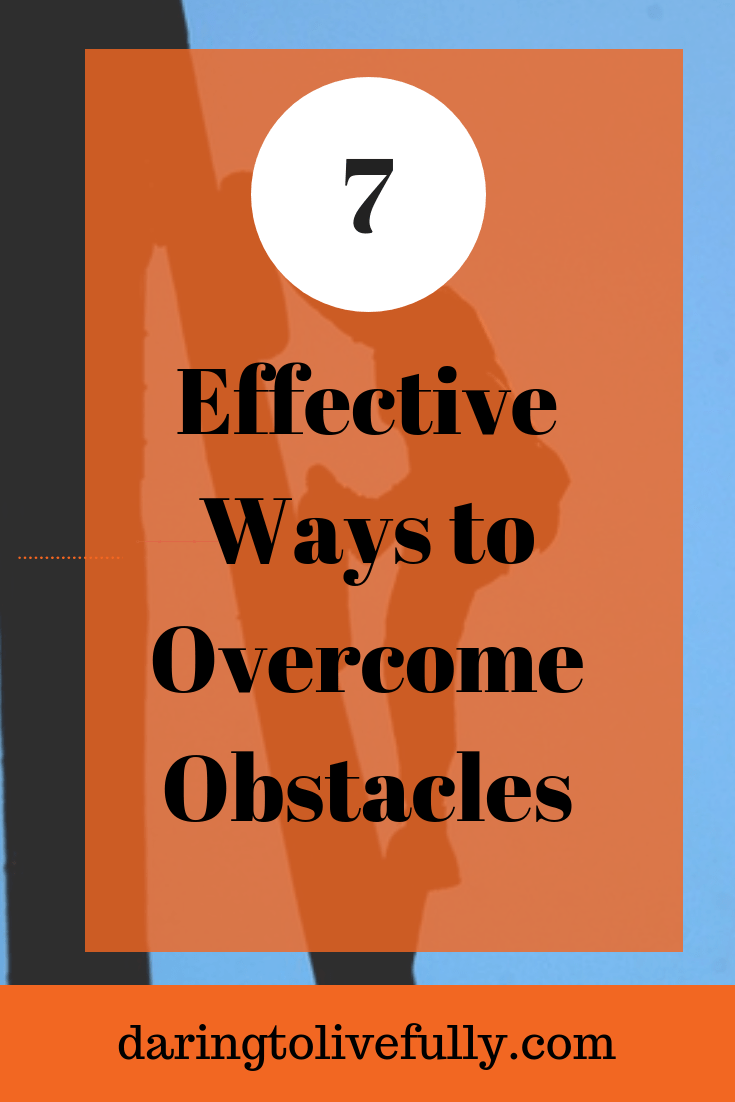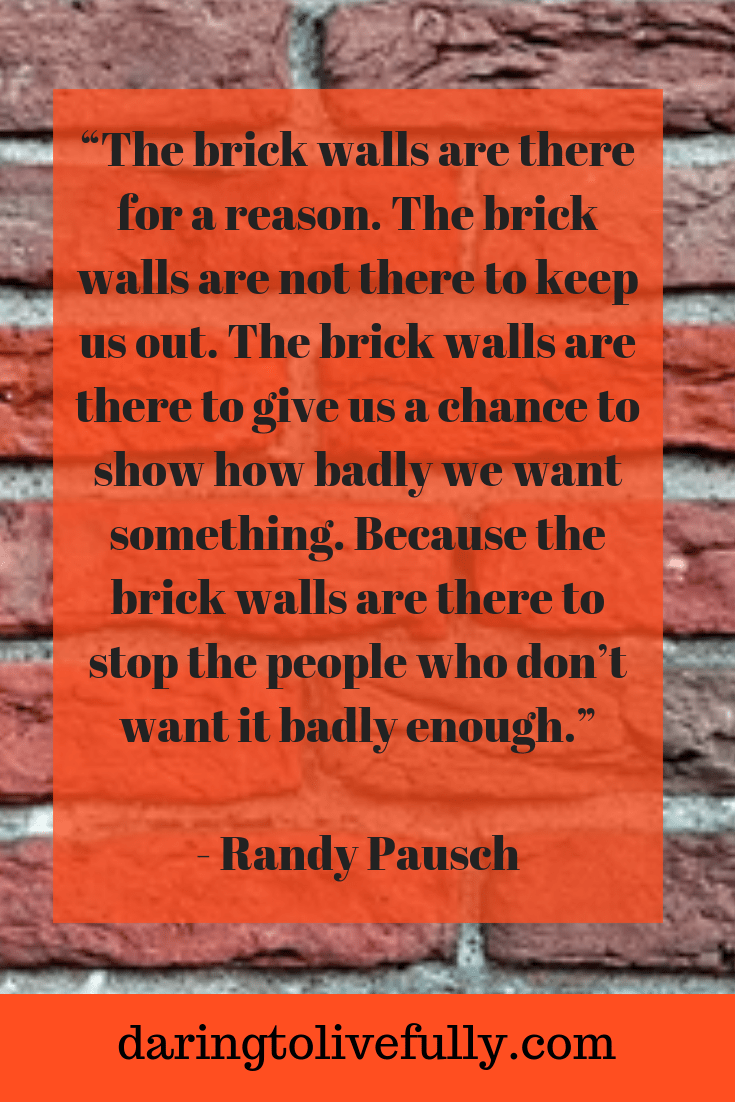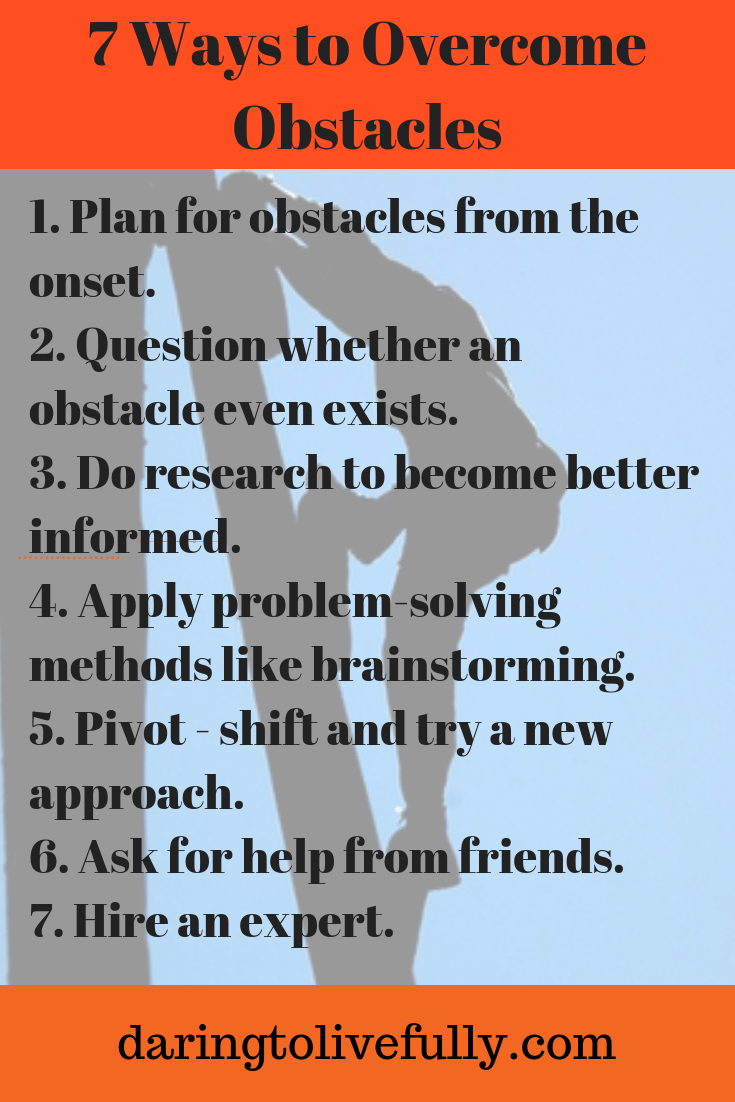
Life is full of obstacles, but there are ways to overcome them.
Any time that you decide to make a change in your life, or to achieve some goal or objective, you’ll have to face obstacles. Some common obstacles include the following:

- Lack of time.
- Lack of money.
- You don’t have access to the necessary resources.
- Fear.
- Other people standing in your way.
- Lack of the necessary knowledge, skills, or credentials.
- Lack of expertise.
- Lack of discipline or willpower.
Many people regard obstacles as dead-ends. When they come across one of these so-called dead-ends, they promptly give up on what they were trying to accomplish. At this point, the excuses begin:
- This is too hard.
- I can’t do this.
- I would have to be smarter, richer, more talented, better-looking, thinner, or younger to be able to do this.
However, instead of seeing obstacles as a dead-end, you should think of them as a brick wall. If you run into a brick wall, what can you do? You can do any of the following:
- Remove the bricks one by one.
- Build a ladder and climb over the wall.
- Look for ways around the wall.
- Find someone who will boost you over the wall.
- Dig a tunnel that runs under the wall.
In this article you’ll find seven effective ways to overcome obstacles. That is, you’ll find seven ways to take down, climb over, or get around the brick walls that stand between you and what you want in life.
Change Your Mindset
To begin with, you need to stop looking at the word “obstacle” as being synonymous with hardship, bad luck, adversity, and so on. That is, stop labeling obstacles as “bad”. Instead, do the following:
- Recognize that obstacles are a natural part of the goal-achievement process.
- Realize that obstacles serve a purpose.
There’s more on these two points below.
Obstacles Are Part of the Process
Recognize that obstacles are a natural part of the process that you need to go through in order to get what you want. Expect obstacles and accept that they’re simply part of the goal-achievement process.
When you’re planning how to achieve a goal, take the perspective of a civil engineer. Before building a road, a civil engineer will survey the landscape across which the road will be built. In the same way, when you’re planning how to achieve a goal, survey the path that you need to follow to achieve said goal.
If the civil engineer notices that part of the landscape contains difficult terrain, they don’t get upset. The difficult terrain is not a bad thing. It’s just something that needs to be addressed in the construction plan.
In much the same way, when you survey the path to your goal, make note of any obstacles that you’re likely to come across. Then, simply address those obstacles in the plan that you will follow to achieve your goal.
Obstacles Serve a Purpose
You can even begin to look at obstacles as a tool for helping you to make choices. A few years ago the “Last Lecture” became an internet sensation. It was a lecture given by a Carnegie Mellon University professor in his forties who had been diagnosed with a terminal disease.
The professor’s name was Randy Pausch, and in his lecture, he said the following about obstacles:
“The brick walls are there for a reason. The brick walls are not there to keep us out. The brick walls are there to give us a chance to show how badly we want something. Because the brick walls are there to stop the people who don’t want it badly enough.”

When you really want something, you should be determined to achieve it, no matter who or what gets in your way. If you lose your motivation to achieve something at the first sign of an obstacle, it’s very likely that it’s not something that you really want after all.
When you run into an obstacle, ask yourself the following:
- How badly do I want this?
- Am I willing to do the work that it’s going to take in order to get it?
- Would my time be better spent doing something else?
Then, if you decide that it’s something that you really do want, start looking for ways over, around, or under the obstacle. On the other hand, if you decide that your time, money, energy, and other resources would be better spent doing something else, go do that.
Overcome Obstacles by Changing Your Perception
Whatever it is that you’re perceiving as an obstacle might not even be an obstacle after all. As an example, suppose that there’s a position that you want to apply for. However, the advertisement for the position indicates that job applicants need to have an MBA, which you don’t have.
There are two approaches you can take. First, you can see the requirement of an MBA as an insurmountable obstacle and you can decide to forget about applying for the position.
The second approach you can take is to question whether the fact that you don’t have an MBA is a dealbreaker after all. It could be that you’re creating an obstacle where there really isn’t one.
After all, what companies are really looking for when they ask for candidates who have an MBA isn’t that they come in with a piece of paper that they can hang from a wall. What they want is the training and expertise that is associated with having an MBA.
If you can show that you have the level of training and expertise that is required–by showing them training certificates or concrete evidence of projects that you’ve worked on that are relevant to the expertise that the company needs– it may very well be that the company decides to hire you.
Therefore, the second strategy you can use to overcome obstacles is to question whether an obstacle even exists. That is, change your perception.
Do Research to Become Better Informed
You could be having trouble overcoming an obstacle because you don’t have enough information to go on. In that case, you need to set aside some time to go online and do some research. Gathering more information can help you with the following:
- It can help you to reframe your problem.
- It can help you to look at the obstacle from a different perspective.
- It can help you to grasp nuances of the problem that you didn’t understand before.
By gathering more information you’re increasing the knowledge base which you’re going to pick through when you’re looking for solutions to your problem. In many cases, the right information will allow you to overcome obstacles.
Brainstorm a List of 100 Possible Solutions
Obstacles can be seen as problems that need to be solved. This approach allows you to overcome obstacles by applying problem solving methods.
Luciano Passuello from the blog Litemind indicates that a great way to come up with a solution to a problem is to create a list of 100 possible solutions. The process is as follows:
- Write down the obstacle that you’re trying to overcome on a piece of paper.
- Number the paper from one to a hundred.
- Then, set aside a block of time—it can be anywhere from forty-five minutes to an hour—during which you won’t be interrupted.
- During that time, you have to generate 100 ways to overcome the obstacle that you’re facing. Write down anything that comes to mind.
While you’re creating your list of 100 solutions, don’t do the following:
- Judge or criticize what you’re writing down.
- Worry about grammar or spelling mistakes.
- Hesitate if some of your ideas are closely related to each other.
You’ll probably discover that the first thirty ideas or so are very safe, and that as you move further down the list you start thinking outside of the box. As Luciano points out, it’s very likely that the gems will be at the very bottom of your list.
A variation of this idea is to generate 100 possible ways to overcome the obstacle that’s standing in your way by creating a mind map. Do the following:
- Place an image in the center of the page that represents the obstacle that you need to overcome.
- From that image, start to radiate out every idea that comes into your mind on possible solutions. For a few minutes simply allow the ideas to flow as fast as possible.
- Then, look at each possible solution that you came up with and see if you can use it as a new starting off point to generate even more ideas.
- Keep going in this way until you’ve come up with 100 possible solutions.
Pivot to Overcome Obstacles
To pivot means to shift and try a new approach. If there’s an obstacle that’s obstructing the path to your goal –and you determine that it would take too many resources to overcome the obstacle–you can choose to do any of the following:
- Modify your goal so that the obstacle is no longer an issue. For example, if you can’t compete in a running race because of knee issues, look for a swimming race. You’ll still be getting the benefits of exercising and the challenge of competing in a race, but by modifying the goal you remove the obstacle.
- Make your goal smaller. If you notice an obstacle at mile 10, choose a goal that can be completed before getting to that point. You can always choose to make the goal larger once you have the necessary resources to overcome the obstacle at mile 10.
- Plot a different path to your goal. Maybe you can’t achieve your goal by following the path you’re currently on because there’s a big ole obstacle in the way. However, it’s very likely that there are alternative paths to your goal that aren’t obstructed. Sit down and plan a different route (even if the new route is longer and on an incline).
Brainstorm Possible Solutions With Others – Have an Idea Party
When there’s an obstacle that you can’t find a solution for by yourself, it’s time to call on others for help. That is, it’s time for an Idea Party. The Idea Party is a concept which Barbara Sher introduces in her book “Wishcraft”.
Ask your friends, family members, and co-workers to come to your Idea Party. Aim for 15 to 20 people–the more varied their backgrounds, the better. You can make it a potluck dinner and have everyone bring something.
After everyone has a plate filled with food and is sitting down, start the brainstorming session. Have pads of paper and writing utensils available.
One by one each person gets a chance to ask the others for help in finding a solution to a problem that they’re having, or overcome an obstacle that’s in their way. The person whose turn it is says the following:
“Here is my wish _____. And here is my obstacle ________.”
Then, everyone proceeds to offer up ideas on how the obstacle can be overcome for a period of about 10 minutes. When you break for coffee and dessert you can continue talking to anyone whose ideas you were particularly interested in.
As Sher explains, isolation is a dream killer. If you want to overcome obstacles, ask for help from friends who want to see you succeed.
Get Expert Advice
When the change that you’re trying to make, or the goal that you’re trying to achieve, is very important to you, and there’s an obstacle that you’re having trouble overcoming, it may be time to hire help from experts. You might need help from any of the following:
- If you’re having trouble losing weight you may want to hire a nutritionist.
- When the obstacle you’re facing involves legal matters, it’s often a good idea to hire a lawyer.
- If the obstacle involves money issues, hiring an accountant or a financial planner could be helpful.
Hiring an expert could save you a lot of time and frustration. In addition, it could even help you save money in the long run.

Conclusion
What obstacles are you currently facing? How can you use the tips above to overcome those obstacles? Live your best life by refusing to allow obstacles to get in your way.





Related Posts:




 Marelisa Fabrega is a lawyer and entrepreneur. She holds a Bachelor of Science in Business Administration from Georgetown University in Washington, D.C., as well as a Juris Doctor from the Georgetown University Law Center. You can learn more about her
Marelisa Fabrega is a lawyer and entrepreneur. She holds a Bachelor of Science in Business Administration from Georgetown University in Washington, D.C., as well as a Juris Doctor from the Georgetown University Law Center. You can learn more about her 





